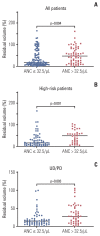Absolute Neutrophil Count after the First Chemotherapy Cycle as a Surrogate Marker for Treatment Outcomes in Patients with Neuroblastoma
- PMID: 33848412
- PMCID: PMC8756108
- DOI: 10.4143/crt.2021.010
Absolute Neutrophil Count after the First Chemotherapy Cycle as a Surrogate Marker for Treatment Outcomes in Patients with Neuroblastoma
Abstract
Purpose: We performed this study to determine whether the degree of neutropenia after the first chemotherapy cycle can be used as a surrogate marker of individual susceptibility to chemotherapeutic agents affecting treatment outcome in patients with neuroblastoma.
Materials and methods: The study included 313 patients who received the first cycle chemotherapy with a CEDC (cisplatin+etoposide+doxorubicin+cyclophosphamide) regimen and had absolute neutrophil count (ANC) data available. The cumulative incidences of progression and treatment-related mortality (TRM) were estimated. To identify genetic variations associated with the ANC, a genome-wide association study (GWAS) was performed.
Results: An ANC of 32.5/μL was determined as the cutoff point to categorize patients into the good and poor prognosis subgroups in terms of progression. Patients with a high nadir ANC had a higher cumulative incidence of progression than those with a low nadir ANC (p < 0.001). In multivariate analysis, high nadir ANC, age, bone marrow involvement, and unfavorable histology were poor prognostic factors. With regard to the TRM, patients with a low nadir ANC (ANC < 51.0/μL) had a higher cumulative incidence of TRM than those with a high nadir ANC (p=0.010). In GWAS, single-nucleotide polymorphisms of LPHN2 and CRHR1 were significantly associated with the nadir ANC.
Conclusion: In neuroblastoma patients, the degree of neutropenia after the first chemotherapy cycle can be used as a surrogate marker to predict an individual's susceptibility to chemotherapeutic agents. Tailoring of treatment based on the degree of neutropenia needs to be considered.
Keywords: Genome-wide association study; Germline; Neuroblastoma; Neutropenia; Treatment outcome.
Conflict of interest statement
Conflict of interest relevant to this article was not reported.
Figures




Similar articles
-
Granulocyte-colony stimulating factor and multiple cycles of strongly myelosuppressive alkylator-based combination chemotherapy in children with neuroblastoma.Cancer. 2000 Nov 15;89(10):2122-30. Cancer. 2000. PMID: 11066054 Clinical Trial.
-
An open-label, multicentre, randomised phase 2 study of recombinant human granulocyte colony-stimulating factor (filgrastim) as an adjunct to combination chemotherapy in paediatric patients with metastatic neuroblastoma.Eur J Cancer. 1998 Jun;34(7):1063-9. doi: 10.1016/s0959-8049(98)00061-6. Eur J Cancer. 1998. PMID: 9849455 Clinical Trial.
-
Safety of discharge for children with cancer and febrile neutropenia off antibiotics using absolute neutrophil count threshold values as a surrogate marker for adequate bone marrow recovery.Pediatr Blood Cancer. 2018 Mar;65(3):10.1002/pbc.26875. doi: 10.1002/pbc.26875. Epub 2017 Nov 8. Pediatr Blood Cancer. 2018. PMID: 29115709 Free PMC article.
-
Clinical outcomes and prognostic factors to predict treatment response in high risk neuroblastoma patients receiving topotecan and cyclophosphamide containing induction regimen: a prospective multicenter study.BMC Cancer. 2019 Oct 16;19(1):961. doi: 10.1186/s12885-019-6186-z. BMC Cancer. 2019. PMID: 31619207 Free PMC article.
-
Ifosfamide, carboplatin, and etoposide for neuroblastoma: a high-dose salvage regimen and review of the literature.Cancer. 2013 Feb 1;119(3):665-71. doi: 10.1002/cncr.27783. Epub 2012 Sep 5. Cancer. 2013. PMID: 22951749 Review.
Cited by
-
Targeting the myeloid microenvironment in neuroblastoma.J Exp Clin Cancer Res. 2023 Dec 13;42(1):337. doi: 10.1186/s13046-023-02913-9. J Exp Clin Cancer Res. 2023. PMID: 38087370 Free PMC article. Review.
References
-
- Maris JM, Hogarty MD, Bagatell R, Cohn SL. Neuroblastoma. Lancet. 2007;369:2106–20. - PubMed
-
- Brodeur GM. Neuroblastoma: biological insights into a clinical enigma. Nat Rev Cancer. 2003;3:203–16. - PubMed
-
- Hero B, Simon T, Spitz R, Ernestus K, Gnekow AK, Scheel-Walter HG, et al. Localized infant neuroblastomas often show spontaneous regression: results of the prospective trials NB95-S and NB97. J Clin Oncol. 2008;26:1504–10. - PubMed
MeSH terms
Substances
Grants and funding
LinkOut - more resources
Full Text Sources
Other Literature Sources
Medical

